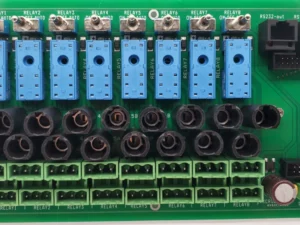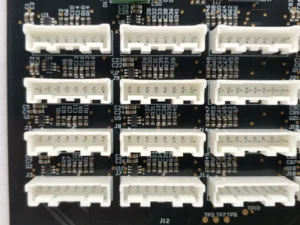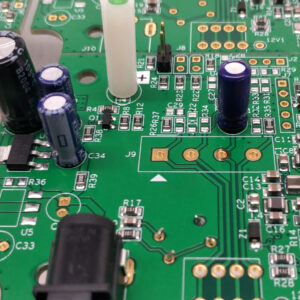We use electronics in a wide range of daily activities, and PCBs are like their brains. We use PCBs in our computers, smartphones, machines, airplanes, and even Mars rovers. All these electronics might experience different environmental factors. One crucial factor is temperature. And that’s where the topic of high-TG PCB comes in.
When you decide to manufacture an electronic device, you must asses in what environment your device will work. It is typically necessary to choose an appropriate PCB for the device. One of the most important considerations here is Glass Transition Temperature or TG. If you’ve never heard of TG, you’re not alone, especially for beginners. However, it’s a critical feature of PCBs.
TG tells you the temperature at which the material changes to soft or leathery. At this stage, your PCB begins to malfunction. Therefore, selecting the right PCB TG temperature is crucial. In this article, we’ll mostly talk about high-TG PCBs. You will specifically learn what makes them unique, why they are essential, and how they’re used.
By the end, you’ll clearly understand why High TG PCB matters. You will also discover how choosing the right PCB can make all the difference.
What is High TG PCB?
In electronics, a high-TG PCB is a material used for high-temperature applications. You may be familiar with FR4 material used in PCB manufacturing. This material can be customized based on your application needs. It is called FR4 High TG material.
Before you understand what high TG PCB is, you must also understand the types of PCB TG classes. In general, there are three major types of PCB TG classes. It is important to remember that the PCB costs more when the TG value is high. Generally, the TG number means the board can handle high temperatures better.
General TG PCB
This type of PCB has a glass transition temperature from 130 to 140 degrees Celsius. This temperature range works well for uses that won’t experience excessive heat. Most general-purpose consumer electronics are made of this type of PCB. They are cheap and also easy to manufacture.
Medium TG PCB
Medium TG PCB, on the other hand, has a TG value of around 150 degrees Celsius. Compared to general-purpose FR4 material, TG150 sheets offer improved characteristics. First, they can resist comparatively higher temperatures. Second, they can withstand moisture and chemicals. This type of PCB is widely used for high-speed digital circuits. It is used in testing machines, home appliances, radar, and other telecommunication circuits.
High TG PCB
Finally, a high-TG PCB has a TG value above 170 degrees Celsius. These PCBs can, as usual, resist high temperatures, moisture, and chemicals. Therefore, they are widely used in high-speed devices and extreme situations.
A high-TG PCB is mainly used for high-density printed circuit boards. It is typically suitable for around ten layers of PCB. It is often found in the auto industry, packaging materials, embedded platforms, routers, precision tools for industrial control, and many other industries. There are several reasons why you should use a high TG PCB.
(1) A high-temperature PCB gives you enhanced thermal stability. It ensures that the PCB doesn’t deform or lose its structural integrity.
(2) A high-temperature circuit board is ideal for high-density PCB. Therefore, it is apparent that these PCBs offer improved mechanical strength.
(3) These PCBs offer excellent reliability, especially in heat-intensive applications. Heat generation is typical in automotive, aerospace, or industrial applications.
(4) High TG PCBs also ensure better moisture and chemical resistance.
(5) Since high TG PCBs are made for high-density circuit boards, they are strong. As a result, they offer improved mechanical strength, resulting in a longer lifespan.
(6) A high TG PCB is primarily suitable for high-frequency circuit boards. This means that you can get better signal integrity.
(7) If you aim to make high-power devices, consider a high-TG PCB. Heat is often generated quickly in high-power devices when dealing with high-processing tasks.
How to Select the Right High-Temperature PCB
You have already learned some basics about high TG PCB. Now, let’s find out how you know which TG value you need for your PCB. But where do you start? You can follow the following pointers for the best PCB to withstand heat.
Application Requirements
Start with the basics: What kind of environment will your PCB face? Will it be exposed to extreme temperatures? Think about the power demands, too. It is apparent that high-powered devices produce more heat. So, the higher the temperature, the stronger the board needs to be. This is especially true for cars, aircraft, or equipment facing severe heat. You’re ready for the next step when you’re clear on the environment.
Electrical & Mechanical Needs
A high-temperature PCB isn’t just about heat. It needs to hold up electrically and mechanically, too. Think about durability here. Will the PCB face a lot of vibration? What about thermal resistance and conductivity?
A high-temperature PCB withstands temperature and maintains performance under harsh conditions. After all, the correct board is an investment in the lifespan of your product.
Material Choice
Another essential element is the material choice. The high TG (glass transition temperature) boards can be made of FR4, Polyimide, or Rogers. FR4 is stable and inexpensive, but Polyimide works even better at high temperatures. Rogers materials work well in high-frequency situations. You should find the material that best fits your needs. Each material has pros and cons. Find out what your choices are; they’re not all the same.
Consult with PCB Manufacturers
Finally, get expert input. Even if you’ve researched, working with experienced manufacturers can give you insights you might miss. They can help you decide the type of material to use, the thickness of the layer to employ, and the changes that need to be made to the design to get the best outcome.
High TG PCB vs FR4 TG PCB
You will be introduced to these two PCB types in the electronics industry. The following table highlights the difference between them.
| Feature | High TG PCB | FR4 TG PCB |
| Definition | PCBs made with materials that have a high glass transition temperature, more than 170 C | FR4 TG is a type of PCB that uses FR4 epoxy as the primary substrate, whose TG ranges from 130 to 150 C |
| Primary Material | Uses specialized high-temperature materials, like polyamide, hydrocarbon, or Teflon-based | Typically, it consists of an epoxy resin reinforced with glass fibers named FR4. |
| Temperature Tolerance | Can withstand temperatures above 170C, in some materials, up to 300C | Generally has a maximum heat tolerance of around 150C |
| Thermal Stability | Maintains structural and dimensional stability even under high temperature | Moderately stable under heat, but excess temperature can damage the PCB |
| Moisture Resistance | Improved resistance to moisture absorption | Moderate moisture resistance; can absorb some moisture over time |
| Cost | Generally, it is more expensive due to specialized materials and improved thermal capabilities. | More cost-effective, making git a popular choice for budget-friendly products |
FR4 TG 150 vs FR4 TG 170
FR4 150 and FR4 170 PCB are commonly used in many electronic devices. These materials are from your computer and smartphones to ovens, stoves, or power supplies.
| Feature | FR4 TG 150 PCB | FR4 TG 170 PCB |
| TG Value | It has a TG of approximately 150 C | Higher TG of around 170 C |
| Ideal temperature | Designed to operate in temperatures from 130 to 150 C | Optimized for environments from 150 to 170 C |
| Thermal Expansion | Experience moderate expansion under elevated temperature | Exhibits lower thermal expansion, maintaining dimensional stability and reliability |
| Mechanical Strength | Provides standard mechanical strength; typically adequate for most regular applications | It offers increased mechanical durability, making it less prone to warping. |
| Performance | Suitable for less demanding applications but may degrade under continuous high-heat exp | The superior choice for high-performance, heavy-duty electronics |
| Cost | More budget-friendly than the FR4 TG 170 | More expensive than FR4 TG 150 |
UETPCB: Your Choice for PCB Manufacturing
UETPCB is a leader in PCB manufacturing. This company has proudly served its customers for more than 20 years. It focuses on producing superior-quality printed circuit boards and has rich experience with high-TG PCB solutions.
- UETPCB provides a customized high-TG Material section. The choice of substrate material varies from FR4 to polyamide or other modern materials.
- We also have expertise in creating various multilayer high TG PCBs.
- We ensure the integration of the most efficient thermal management features.
- At UETPCB, we adhere to various test procedures, such as thermal cycling and stress testing.
Summary
Let’s wrap up! Glass transition temperature, or TG, is critical to designing a PCB. It is an essential aspect in assessing a PCB’s performance under heat. You may prevent difficulties by selecting the appropriate TG. So, what are the many forms of TG classification?
First, there are generic TG PCBs that are appropriate for everyday electronics. Second, a medium TG PCB is suitable for high-performance computer systems. Finally, the high TG PCB is more temperature-resistant, making it appropriate for extreme-condition applications.
Why should you use high-TG PCBs? First, they offer better thermal stability than the standard TG PCB. This means they will not deform or lose functionality at high temperatures.
Selecting the correct PCB for your project isn’t just a box to tick. It’s about finding the right fit for your needs. Consider the temperature range, the electrical demands, and the environmental factors. If you have any questions, contact our customer support team.



